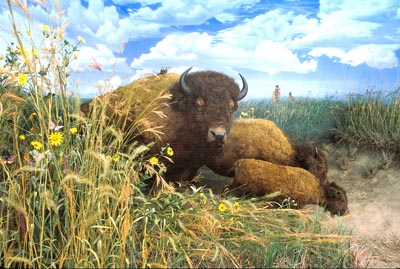
Illinois State Museum
Click on active areas for more information on soil, plants, and animals.
Central Prairie
McLean County, 1673
This is a tallgrass prairie in the summer of 1673. The Grand Prairie once covered most of the northern two-thirds of Illinois. Early European explorers and settlers were amazed by the seemingly endless sea of grasses and wildflowers—some so tall that a man on horseback could ride through unseen.
“We now took up our journey across the plains...Fields of prairie
frequently spread before the eye, like the boundless expanse of the ocean… Its
apparent boundary is the horizon… So vigorous a growth of grasses
and flowering plants, covers these plains, that in several places, we found
them to overtop our shoulders, sitting on horseback; a proof, if any proof
were wanting, of the strength and richness of the soil."
—
Henry Rowe Schoolcraft 1821
Regular fires maintained a dense cover of prairie grasses, preventing the invasion of woody trees and shrubs. Over thousands of years, the prairie's annual cycle of growth and decay created deep, fertile soil.
This reconstruction is based on historic records, archaeological evidence, and studies of the geology and ecology of the Grand Prairie Division of central Illinois.
To read more about the Illinois Prairie, go to the Museum's Illinois
Prairie Web Exhibit and to Prairies
in the Prairie State Web exhibit.